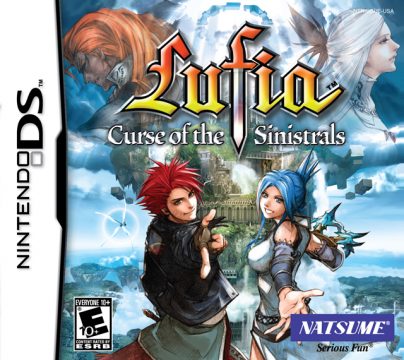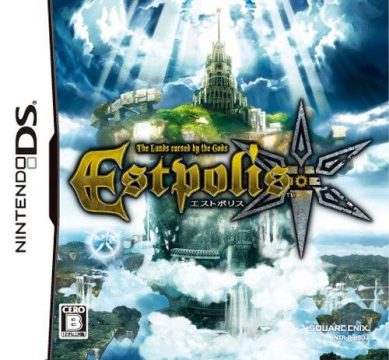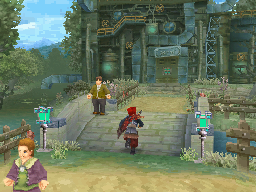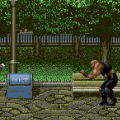- Lufia & The Fortress of Doom
- Lufia II: Rise of the Sinistrals
- Lufia: The Legend Returns
- Lufia: The Ruins of Lore
- Lufia: Curse of the Sinistrals
Lufia: Curse of the Sinistrals for the Nintendo DS is a complete overhaul of Lufia II, less of a remake and more of a reimagining. It features the same characters and same basic plot, but drastically reworks practically every element to a whole new game.
The game switches genres from a The Legned of Zelda / Final Fantasy hybrid to an action-RPG. That means, of course, no more turn based battles. The game was developed by Neverland, a company made up of several staff members who worked on the SNES titles. They also developed Shining Force Neo and Shining Force EX for the PlayStation 2, two hack-and-slash games related to Sega’s strategy game series, as well as Record of Lodoss War for the Dreamcast. However, while these are straight forward dungeon crawlers, similar to a Japanese take on Diablo, Curse of the Sinistrals borrows some of the battle mechanics but expands it with platforming and puzzle solving elements, so it still has its own unique feel. Characters can attack, jump and roll, and the IP gauge, which automatically regenerates after time, dictates how often the player can use special attacks.
At any given time, up to three party members are active on the field. One is controlled by the player, and they can be switched between at any time. Previously Maxim used tools to solve puzzles, but now each character has their own skill. For example, Tia provides the grappling hook ability for the party – which now also lets you collect hard-to-reach items, in addition to letting you pull yourself across gaps. Other characters have ranged attacks, or the ability to destroy obstacles in the environment. The adjustment of the game to an action RPG has also lead to some changes in the game’s environments. As new members join the party, sometimes the player is sent back to an earlier dungeon, with an area that was out of reach earlier now accessible due to a character’s ability, or otherwise set up to train the player in combining the party members various abilities. While you can have several characters in your party, only the active character collects the most experience. Thus, you have to constantly shuffle characters to keep everyone on top of their game.
The overworld is completely gone, instead replaced with a level select screen. There are less locations than Lufia II, both towns and dungeons, which makes for a more compact game. Despite how much is cut out, most of it was filler anyway, so the pacing is much improved. All areas have been completely redesigned from scratch, so don’t count on seeing any familiar areas or puzzles from the SNES game.
Both the characters and the environments are fully 3D. Most 3D titles on the DS look terrible, but Curse of the Sinistrals is one of the better looking ones. Part of this has to do with the art design, so the game looks decent in spite of the low resolution textures. While the SNES game had the generic 16-bit RPG look, the DS remake ensures better captures the fantasy/science hybrid aethetics, with each town and area having a unique design. The bottom screen is used for gameplay, and the top screen typically shows a map, but sometimes it switches over to a gameplay screen as well, making one large vertical image. This is typically used for cutscenes and for boss battles, making fights against them truly epic.
Unfortunately, it’s still held back by some technical restraints, as there’s some pretty significant slowdown during battle. The movement is still a bit clumsy compared to other faster games like Ys Seven, which Curse of the Sinistrals otherwise resembles. 3D movement on the digital direction pad on the DS is also not exactly adequate, though the circle pad on the 3DS allows for smoother control. Even though there’s a map screen, some areas are confusing laid out, since the camera is zoomed in.
The game’s story is also much, much different, even though the basic plot is the same. The difference is evident right at the beginning – in the SNES game, Maxim took on a few monster hunting jobs before learning of the resurgence of the Sinistrals, but in the DS game, they’ve already appeared, and he begins to launch a (failed) attack on their lair. At this point, the inventor Lexis has already joined up, whereas he wasn’t encountered until later on in the SNES game. Many of the basic story beats and events are the same. There’s still a scene where Tia cooks a rather terrible meal for Maxim, making her affections clear to the player (though not to Maxim). Maxim and Selan’s meet-cute at Parcelyte Castle is pretty similar. Bart and Berty (the latter renamed Betty here), the comic relief thieves, make a similar entrance, although this time they run off to the Tanbel mines instead of the castle basement. While gamers unfamiliar with the SNES game enjoy it without a problem, it’s also designed so that old fans can see these events have been rearranged. The game still ends with the sacrifice of Maxim and Selan. However, New Game+ offers the choice for an alternate, non-canon ending, which allows for a (slightly) happier finale.
The script is longer, with more cutscenes and better characterization, along with voiced dialogue. All of the characters have been redesigned too, some more than others. The SNES game didn’t feature any detailed character artwork, just chibi sprites, but the character illustrations found in supplemental material was a little closer to Western fantasy material. In the DS game, everyone has been redrawn in a contemporary 00s anime/manga style, with some other changes. Dekar now has pink hair, for example, and ditches his heavy armor for a more suave getup.
In the process, many of the characters’ personalities have changed too. In the SNES game, Tia was rather meek, and she bailed out fairly on in the quest, once she realized her romance with Maxim wasn’t going anywhere. In the DS game, she’s still set up as Maxim’s beleaguered childhood friend, but she’s much more confident, and is presented as a girl who looks like a mechanic (and attacks with a gigantic suitcase), rather than a whip-wielding shopkeeper. She also spends the entire adventure with the party, and finds other romantic opportunities instead of just taking off. Iris now tags along with most of the group instead of just popping up every once in awhile to give advice, though she’s still not a playable character. Some characters use different weapons, like Selan now uses chakrams and Artea uses guns. And Lexis has been demoted from a playable character to an NPC, but is now more of a mad scientist, whose design looks a lot like Christopher Lloyd’s Doc Brown from Back to the Future.
The one major connection with the SNES game lies with the music. Most of the soundtrack is reused, and is just as excellent as it was before. It sounds slightly different than it did on the SNES, but not in a bad way, with cleaner samples that sound less artificial. Since there’s no longer any separate battle screens, most of the fighting music has instead been recast as boss themes.
On its own, Lufia: Curse of the Sinistrals is pretty decent. The fighting mechanics could’ve been tighter and the dungeons aren’t as well designed, but it’s one of the better action RPGs on the DS, and for the most part, it improves on the plot from the original. Unfortunately, many Lufia fans had mixed reactions to drastic overhaul of the game, both from a storyline and gameplay standpoint and it failed to expand outside of that audience, so it was considered a flop.
In Japan, the game was published by Square-Enix in 2010, who at this point had purchased Taito. In North America, it was published by Natsume, who had also handled the previous English games in the series. Again, the translation has some typos, but the voice acting is generally pretty good considering it probably had a low budget. Unfortunately, the party talk sequences, where the characters had optional discussions to flesh out their personalities, were removed from the English version, even though traces of their voice acting can be found hidden within the game.
Artwork Comparisons
Maxim
Dekar
Artea
Lexis
Tia
Selan
Iris
Guy




